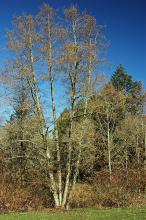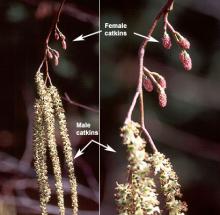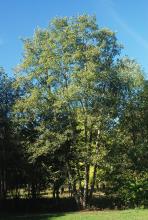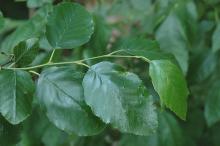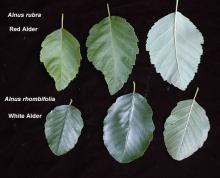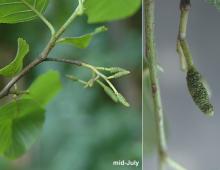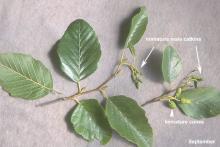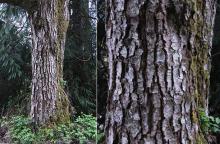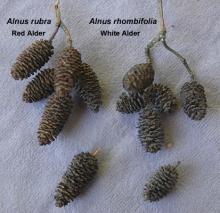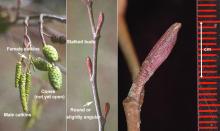Alnus rhombifolia
Common name:
White Alder
Pronunciation:
AL-nus rom-bi-FO-le-ah
Family:
Betulaceae
Genus:
Type:
Broadleaf
Native to (or naturalized in) Oregon:
Yes
- Deciduous tree, mature trees are generally 50-80 ft (15-24 m) tall, record trees reach over 100 ft (30 m), the crown is open, broadly rounded in shape, branches slender and nodding at the ends. Mature forest trees often have several trunks arising from a single clump. Winter buds about 13 mm long, slender, dark red, covered with a pale pubescence. Bark is light gray, whitish, smooth or slightly rough on young trees but becomes plated and reddish-brown at maturity. Leaves alternate, simple, elliptic to rhombic, 6-10 cm long, 4-5 cm wide, rounded or acute at the apex, gradually or abruptly narrow and wedge-shaped at the base, singly or doubly serrate, somewhat undulating margins, dark green and glossy above, often minute glandular dots on the midrib, yellow-green below. Male (pollen) catkins in groups of 2-7, each about 10-15 cm long and 0.5 cm wide at pollination (early spring). Female flowers short, erect catkins small clusters, they emerge in winter, mature seed catkins (cones), are woody, barrel-shaped, 10-15 mm long.
- Sun. Fast growing, tolerant of heat and wind, susceptible to tent caterpillars and borers in its native range. Tolerates infertile soil because it forms an association with a small soil bacteria, Frankia, resulting in root nodules that transform the tree into a nitrogen fixer.
- Hardy to USDA Zone 6 Native range extends along the Pacific Coast from southern British Columbia, Washington, Oregon, California and Baja California, eastward along the main tributaries of the Columbia River into eastern Idaho. Generally found on moist sites along streams and on lower mountain slopes.
- White alder is closely related to red alder (Alnus rubra). Although the two species are difficult to differentiate when growing together, their distribution and habitats do not overlap to any great extent. In the summer, leaf characteristics can be used to separate these alders; the leaf margin of red alder is rolled under (revolute) but not that of the white alder.
- rhombifolia: Latin, with rhombic leaves
- Corvallis: street trees on the west side of 6th St. between Jefferson Ave. and Adams Ave.

